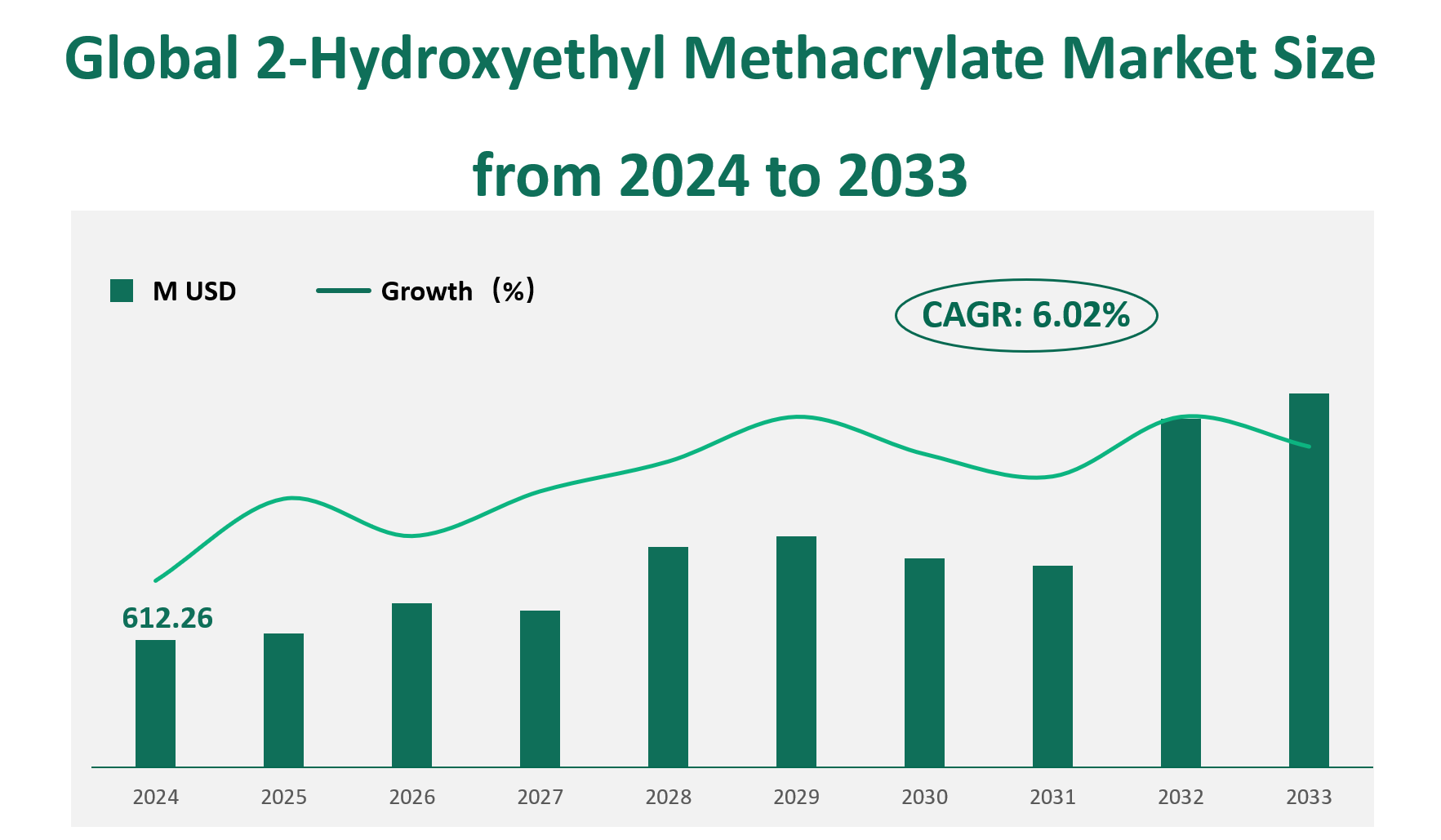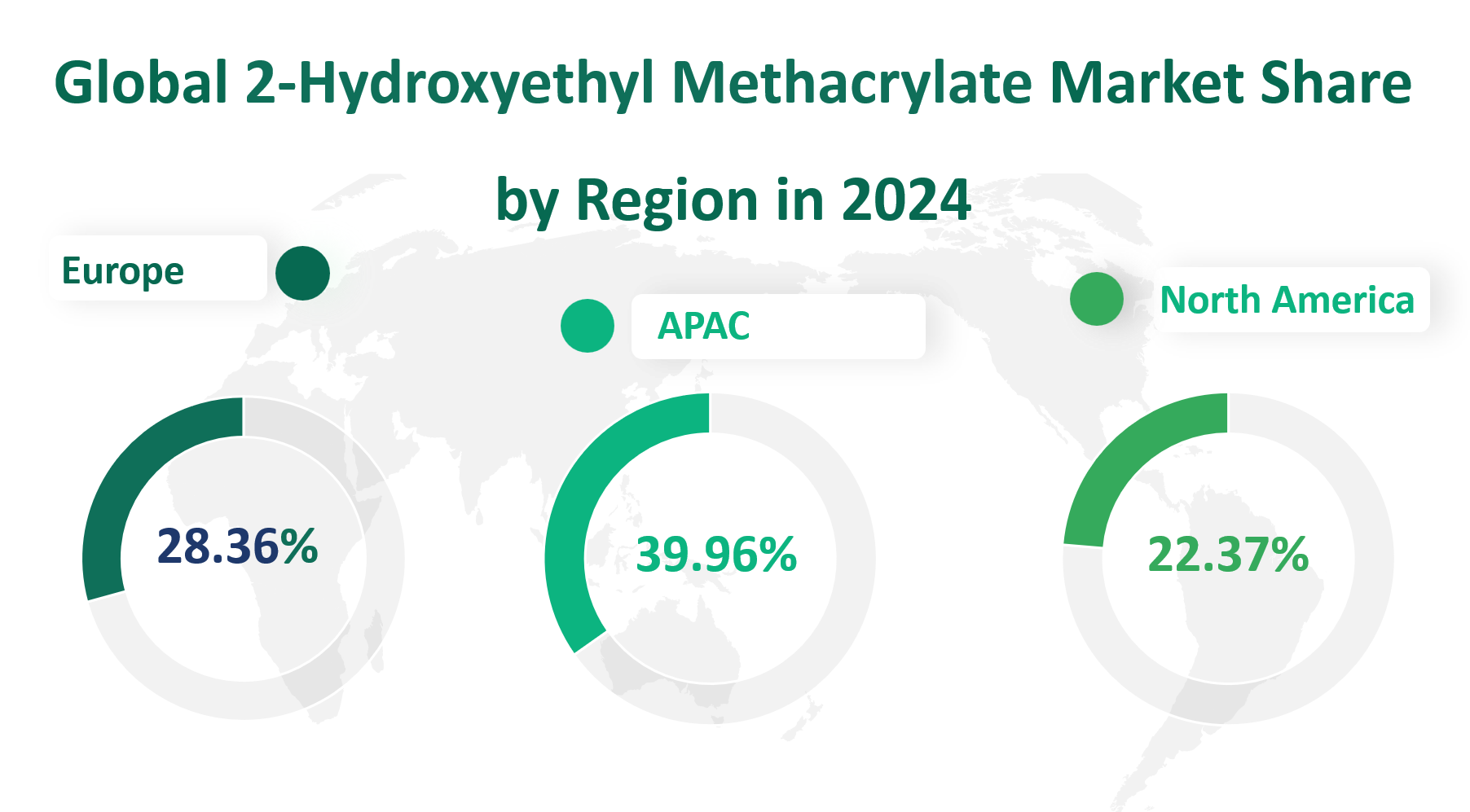1. Global 2-Hydroxyethyl Methacrylate Market Revenue and Future Growth
In 2024, the global 2-Hydroxyethyl Methacrylate (HEMA) market is projected to reach a revenue of approximately 612.26 million USD, with a Compound Annual Growth Rate (CAGR) of 6.02% from 2024 to 2033.
2-Hydroxyethyl Methacrylate (HEMA) is a versatile chemical compound with the molecular formula C6H10O3 and a CAS number of 868-77-9. It is a colorless, transparent liquid primarily used as a monomer in the production of acrylic resins, coatings, textile agents, adhesives, and additives for decontaminating and lubricant applications. HEMA is characterized by its ability to copolymerize with other monomers to produce copolymers with hydroxyl groups, which enhances the functionality and performance of the resulting materials.
Figure Global 2-Hydroxyethyl Methacrylate Market Size (M USD) and CAGR (2024-2033)

2. Driving Factors and Limiting Factors of 2-Hydroxyethyl Methacrylate Market
The growth of the 2-Hydroxyethyl Methacrylate market is primarily driven by the increasing demand from downstream industries. HEMA’s unique properties, such as its ability to self-polymerize and its biocompatibility, make it an essential component in various high-performance materials. The construction industry, in particular, is a significant driver of demand, with the increasing need for adhesives and sealants in residential and commercial projects. The growing populations and urbanization in developing countries such as China, India, and Brazil are fueling the demand for permanent housing, which in turn drives the need for HEMA-based products.
Another key driver is the expanding automotive industry, where HEMA is used in the production of advanced coatings and adhesives. The need for high-performance materials that offer durability, aesthetics, and environmental resistance is driving the adoption of HEMA-based products in this sector. Additionally, the healthcare industry’s demand for high-quality dental and orthopedic materials is also contributing to the market’s growth.
Despite the significant growth potential, the 2-Hydroxyethyl Methacrylate market faces several challenges. One of the primary limiting factors is the high technical and talent barriers associated with the production of HEMA. The industry requires strong technical capabilities, particularly in process technology and quality control, which can be difficult to achieve without significant investment in research and development. Additionally, the need for specialized equipment and continuous innovation in purification methods and preparation processes creates a barrier for new entrants.
Another challenge is the risk of rising raw material prices. HEMA’s production relies heavily on chemicals such as methacrylic acid and ethylene glycol, which are subject to price fluctuations due to supply chain disruptions and geopolitical events. The ongoing conflict between Russia and Ukraine, for example, has led to increased costs for methacrylic acid, putting pressure on HEMA manufacturers. These cost increases can affect profitability and limit market expansion.
Environmental regulations also pose a significant challenge. The production of HEMA involves the generation of pollutants, and companies must invest in advanced environmental protection facilities to comply with increasingly stringent regulations. The risk of environmental accidents and the need for continuous investment in environmental management can add to the operational costs and complexity of HEMA production.
3. 2-Hydroxyethyl Methacrylate Market Technology Innovation and Corporate Mergers and Acquisitions
The 2-Hydroxyethyl Methacrylate market is characterized by continuous technological innovation aimed at improving product quality and expanding application scopes. Companies are investing heavily in research and development to develop new formulations and production processes that enhance the performance and sustainability of HEMA-based products. For example, advancements in polymerization techniques are enabling the production of HEMA with higher purity and better performance characteristics, opening up new opportunities in high-end applications such as medical devices and advanced coatings.
Corporate mergers and acquisitions are also playing a significant role in shaping the market landscape. Major players such as Evonik, Mitsubishi Rayon, and Nippon Shokubai are leveraging strategic acquisitions to expand their product portfolios and enhance their market positions. These consolidations are allowing companies to achieve economies of scale, improve their R&D capabilities, and strengthen their global reach. For instance, Evonik’s expansion of its production facilities for organic dispersions highlights the company’s commitment to meeting growing market demand and supporting its customers with innovative solutions.
4. Global 2-Hydroxyethyl Methacrylate Market by Purity
2-Hydroxyethyl Methacrylate (HEMA) is a versatile monomer used in the production of acrylic resins, coatings, adhesives, and other specialty chemicals. The purity of HEMA is a critical factor that influences its performance and applicability in various industries. The market for HEMA is segmented based on its purity levels.
93%–97% Purity range is suitable for applications requiring moderate performance characteristics. It is often used in general-purpose coatings and adhesives where high purity is not a strict requirement. In 2024, the market revenue for HEMA in this purity range is projected to be approximately 135.50 million USD.
97%–99% Purity range is used in applications where superior performance and consistency are required. It is commonly used in high-end coatings, adhesives, and specialty chemicals. The market revenue for HEMA in this purity range in 2024 is estimated to be around 261.70 million USD.
Above 99% Purity range is used in the most demanding applications, such as high-performance coatings, medical devices, and electronics. The market revenue for HEMA in this purity range in 2024 is expected to be about 215.07 million USD.
Among the different purity levels, the 97%–99% purity range holds the largest market share. This segment’s dominance can be attributed to its wide applicability across various industries, including automotive, aerospace, and electronics, where high-performance materials are essential. The high purity ensures better performance, durability, and reliability, making it a preferred choice for manufacturers.
Table Global 2-Hydroxyethyl Methacrylate Market Size and Share by Purity in 2024
Purity | Market Size (M USD) 2024 | Market Share |
93%–97% | 135.50 | 22.13% |
97%–99% | 261.70 | 42.74% |
Above 99% | 215.07 | 35.13% |
5. Global 2-Hydroxyethyl Methacrylate Market by Applications
HEMA finds extensive use in various applications due to its unique chemical properties, such as its ability to copolymerize with other monomers and its reactivity. The key applications of HEMA include:
HEMA is used to produce high-performance coatings and reactive resins that offer excellent adhesion, durability, and resistance to environmental factors. These coatings are widely used in the automotive, aerospace, and industrial sectors. In 2024, the market revenue for HEMA in Coatings & Reactive Resins segment is projected to be around 550.53 million USD.
HEMA-based adhesives are known for their strong bonding capabilities and are used in various industries, including construction, automotive, and electronics. The market revenue for HEMA in adhesives in 2024 is estimated to be approximately 40.69 million USD.
Table Global 2-Hydroxyethyl Methacrylate Market Size and Share by Application in 2024
Application | Market Size (M USD) 2024 | Market Share |
Coatings & Reactive Resins | 550.53 | 89.92% |
Adhesives | 40.69 | 6.65% |
Others | 21.04 | 3.44% |
6. Global 2-Hydroxyethyl Methacrylate Market Size by Region
North America is a significant market for 2-Hydroxyethyl Methacrylate, driven by the presence of key manufacturers and a well-developed industrial base. In 2024, the market revenue for HEMA in North America is projected to be approximately 136.95 million USD. The United States, in particular, accounts for the majority of the market share within the region, with Canada contributing a smaller but significant portion. The growth in North America is primarily driven by the demand from the automotive and construction industries, which rely heavily on high-performance coatings and adhesives.
Europe is another major market for HEMA, with a diverse range of applications across various industries. In 2024, the market revenue for HEMA in Europe is expected to reach around 173.61 million USD. Countries such as Germany, the United Kingdom, France, and Italy are key contributors to the European market. The demand for HEMA in Europe is driven by the automotive, aerospace, and industrial sectors, which require high-quality coatings and adhesives.
The Asia-Pacific region is the largest market for 2-Hydroxyethyl Methacrylate in terms of revenue, driven by rapid industrialization and urbanization. In 2024, the market revenue for HEMA in the Asia-Pacific region is projected to be approximately 244.64 million USD. China and Japan are the leading markets within the region, followed by South Korea, India, and Australia. The growth in the Asia-Pacific region is primarily driven by the automotive, construction, and electronics industries, which have a high demand for high-performance coatings and adhesives.
Latin America is a growing market for HEMA, driven by the increasing demand from the construction and automotive industries. In 2024, the market revenue for HEMA in Latin America is expected to be around 33.26 million USD. Brazil and Mexico are the key markets within the region, with significant contributions from Argentina and other South American countries.
The Middle East and Africa region is a smaller but growing market for HEMA, driven by the increasing demand from the construction and automotive industries. In 2024, the market revenue for HEMA in the Middle East and Africa is projected to be approximately 23.81 million USD. Turkey, Saudi Arabia, and the United Arab Emirates are the key markets within the region.
Figure Global 2-Hydroxyethyl Methacrylate Market Size by Region in 2024

7. Global 2-Hydroxyethyl Methacrylate Market Analysis by Major Players
7.1 Evonik
Introduction and Business Overview: Evonik is a leading specialty chemicals company with a global presence. Established in 2007, Evonik operates manufacturing bases primarily in Europe, North America, and Asia-Pacific. The company is renowned for its innovative solutions and commitment to sustainability. In October 2021, Evonik expanded its production of organic dispersions for heat sealing applications, supporting the packaging industry’s need for easier-to-recycle plastic materials.
Products Offered: Evonik offers a range of HEMA products, including VISIOMER® HEMA 98, which is used in coatings, adhesives, and reactive systems.
Sales Revenue in 2022: 172.74 million USD
7.2 Mitsubishi Rayon
Introduction and Business Overview: Mitsubishi Rayon, established in 1950, is a leading chemical manufacturer in Japan. The company specializes in a wide range of products, from natural gas to advanced functional materials. Mitsubishi Rayon leverages proprietary technology to develop innovative materials that meet societal needs.
Products Offered: Mitsubishi Rayon produces high-purity HEMA, which is used in coating compounds, photosensitive resins, and contact lenses.
Sales Revenue in 2022: 75.49 million USD
7.3 Nippon Shokubai
Introduction and Business Overview: Nippon Shokubai, founded in 1941, is a global chemical company with a strong presence in the United States and Asia-Pacific. The company is known for its unique catalyst technology and a diverse product portfolio, including ethylene oxide, acrylic acid, and superabsorbent polymers.
Products Offered: Nippon Shokubai offers HEMA with applications in paints, contact lenses, adhesives, and printing inks.
Sales Revenue in 2022: 43.32 million USD

